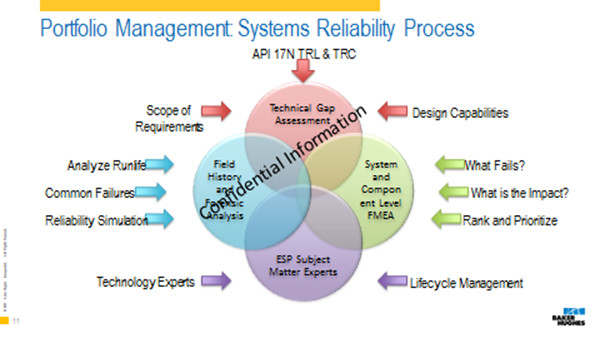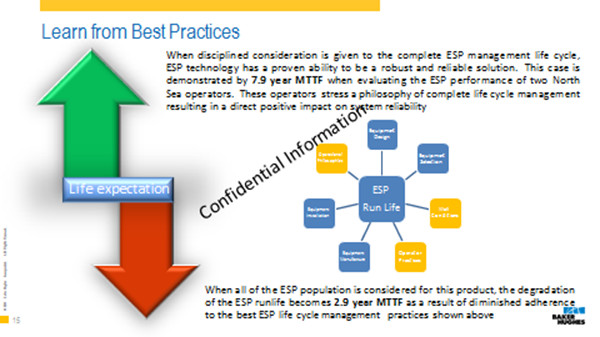Deepwater operators have been reluctant thus far to use in-well electric submersible pumps (ESPs) because of concerns about system reliability in wells where intervention costs are extremely high. But, if early predictions about recovery factors of Lower Tertiary wells prove accurate, in-well ESPs may be necessary to achieve economically sustainable ultimate recovery in this and other deepwater and ultradeepwater basins.
Based on these predictions and intense research into ESP reliability improvement, Baker Hughes has concluded that a new, granular approach to reliability is needed, wherein required reliability is determined and validated at the component level and then rolled up to the system level. Greater confi dence in overall ESP system reliability will enhance adoption of in-well ESPs to optimize ultimate recovery from deepwater and ultradeepwater assets.
Lower Tertiary’s need and challenge for ESPs
The Gulf of Mexico’s Paleogene play, also known as the Lower Tertiary, has been described as a potential 21st century “black gold rush” for the energy industry. The size of the prize—14 Bbbl to 40 Bbbl—is huge, but so are the challenges. Water depths are 1,524 m to 3,048 m (5,000 ft to 10,000 ft), and reservoirs run as deep as an additional 7,925 m (26,000 ft) beneath the seabed. In addition, downhole temperatures are up to 150 C (300 F), and reservoir pressures can reach 25,000 psi.
Lower Tertiary oil does not fl ow naturally to the surface like it does in many other reservoirs. As a result, although average recovery factors may be high initially, predictions are that the decline curve will be earlier and steeper than may have been expected.
To achieve desired recovery rates in an area where gas lifting will be extremely diffi cult, if not impossible, some operators have already installed ESP systems at the mud line. Placing an ESP deep in the well close to the reservoir can tremendously enhance recovery factors by significantly reducing the bottomhole pressure and allowing more production infl ow. However, if a pump fails early or unpredictably, all of these benefi ts can be quickly offset in deepwater projects, where the cost to pull and replace a system may range from $30 million to $80 million. This is why in-well ESPs are not enjoying quick adoption in the Lower Tertiary and other global deepwater basins.
Even in shallower waters, operators need to reliably predict ESP runlife so they can more accurately evaluate their anticipated operating expenses as well as plan for intervention downtime. Unplanned downtime is always expensive, but in deepwater it can jeopardize or even destroy a project. Therefore, operators with deepwater projects that are using or contemplating using ESPs require that they be highly reliable.
Scientific approach
In-well ESP reliability has significantly improved over previous levels. Many problematic issues have been removed by identifying shortcom-ings and addressing them. Many ESP systems have an excellent chance of having a three- to five-year runlife. Yet the 10-year runlife that many operators desire for deepwater applications hasn’t been achieved yet.
As Baker Hughes renewed its focus on research into ESP reliability improvement, it became apparent that a more scientific and comprehensive approach to determining the right areas of focus was necessary. Allocating reliability requirements at the component level had been applied successfully across numerous mission-critical systems but never for ESPs.
The process for system-reliability management (Figure 1), based on component-level reliability allocation, establishes what fails, models around it and validates improvement. The process hierarchy is as follows:
• Field data from previous systems are compiled and studied to understand how long certain components last under various operating conditions. Tasks include determining relevant failure distribution, establishing mean time to failure, analyzing failure reports and consulting with regional engineers and design authorities;
• Numerical models are built and tuned to match the historical information;
• Improvements are simulated by adjusting reliability allocation at the component level, translating the reliability up to the system level and evaluating whether the outcome meets the targeted reliability requirements; and
• Improvement targets are validated through exhaustive reliability testing at both a component and system level.

This method reduces time and expense by compressing and accelerating the testing process and enabling better control of the parameters during the accelerated reliability testing. Through simulations, the mathematical models can be tuned to match what was seen in the field and then altered to determine how systems would perform today. Through this process, it is possible to determine what needs to be done to improve component reliability and how the entire system is impacted by improving the reliability of that component.
Designing for reliability
Based on component-level reliability allocation, ESP components can be designed to include the necessary reliability as a requirement. For Baker Hughes, some examples of the ESP components that are subject to reliability assessments include O-rings, metal bellows, metal sealing elements, motor magnet wire insulation, electrical connections, thrust and radial bearings, motor oil, and materials. At the company’s artificial lift research and technology center in Claremore, Okla., component validation and verification include bench testing of all ESP components and assemblies as well as simulated condition testing in various loops, simulators and specific testing apparatus. System performance testing takes into account ESP system configuration and in situ simulation, including cable and umbilical lengths.
Learning from best practices
Designing for reliability is an important factor in ESP runlife, but it is only one of many factors, as Figure 2 indicates. For example, two North Sea operators that stress a philosophy of complete ESP life-cycle management have seen a direct positive impact on system reliability when disciplined consideration is given to best practices throughout the life cycle. For these operators, ESP technology has proven to be a robust and reliable solution. This case is demonstrated by a 7.9-year mean time to failure (MTTF) when evaluating ESP performance. Conversely, when the total ESP population in a database is considered, the degradation of runlife becomes 2.9 years MTTF as a result of diminished adherence to best practices.

Planning ahead
The intervention costs in deepwater and ultradeep water leave operators with two options for in-well ESPs:
• Make systems more reliable so intervention will be required less often. Dual completions could fit into this category; and
• Make systems easier and less expensive to intervene.
This option also could include alternate deployment methods such as coiled tubing, cable and slickline.ESP systems with high reliability are being developed through a process of allocating reliability to a component level. With this approach, operators can have a high degree of confidence as to how long a system will last and can use reliability curves to plan interventions.
Recommended Reading
The Private Equity Puzzle: Rebuilding Portfolios After M&A Craze
2025-01-28 - In the Haynesville, Delaware and Utica, Post Oak Energy Capital is supporting companies determined to make a profitable footprint.
Not Sweating DeepSeek: Exxon, Chevron Plow Ahead on Data Center Power
2025-02-02 - The launch of the energy-efficient DeepSeek chatbot roiled tech and power markets in late January. But supermajors Exxon Mobil and Chevron continue to field intense demand for data-center power supply, driven by AI technology customers.
Oil, Gas and M&A: Banks ‘Hungry’ to Put Capital to Work
2025-01-29 - U.S. energy bankers see capital, generalist investors and even an appetite for IPOs returning to the upstream space.
Utica Oil Player Ascent Resources ‘Considering’ an IPO
2025-03-07 - The 12-year-old privately held E&P Ascent Resources produced 2.2 Bcfe/d in the fourth quarter, including 14% liquids from the liquids-rich eastern Ohio Utica.
USEDC’s Plans for $1B in Capex, M&A on Track as Oil Prices Stumble
2025-04-11 - Volatility won’t affect Permian Basin-focused U.S. Energy Development Corp.’s day-to-day operations or its plans for deals, CEO Jordan Jayson told Hart Energy.
Comments
Add new comment
This conversation is moderated according to Hart Energy community rules. Please read the rules before joining the discussion. If you’re experiencing any technical problems, please contact our customer care team.





